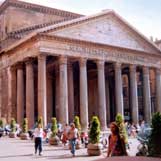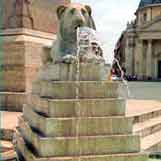Best Sights
in Rome
These
are our recommendations for the top sights in Rome. Please also see our pages about Rome's Piazzas
and the Vatican.
Colosseo
(Coliseum)- Probably Rome’s most recognizable
sight, its official name is the
Amphiteatrium Flavium, named for the emperor who started the construction,
completed in A.D. 80. The name Colosseo came from the colossal statue of
Nero that once stood just outside.
The
venue held up to 50,000 spectators at once for gladiator fights, battles with wild
animals, and (though some historians dispute it) naval battles when the arena was
flooded . Overhead was a canvas cover raised like sails. Below, what was once
a wooden floor covered with sand, is a labyrinth of tunnels and elevator shafts used to house the
slaves, animals and other participants.
Eventually
the Coliseum was abandoned, fell into disrepair and was used as a
marble quarry for some of the Christian monuments of Rome.
Next
to the Coliseum is the Arch of Constantine, built in 315 to honor the
emperor’s victory over the pagan Maxentius.
Foro
Romano (Roman Forum)-
The
Roman Forum (one of many in Rome) is just a short walk from the
Coliseum and down the hill from Circus Maximus (an Ancient Chariot Race Track).
It has many ruins but only a few standing buildings. This area was the
heart of ancient Rome for thousands of years. Today you can wander through
the forum and imagine what life was like in ancient Rome’s heyday.
Detailed
maps of the forum are often confusing and the sights not as exciting as the maps
portray. An interesting way to see the forum is on one of the free guided
tours that you will see advertised. These tours are offered by
companies hoping that you will take later paid tours in other parts of
Rome. A small tip to your free guide, often young students, is appropriate
if you thought they did a good job.
Palatino
(Palatine Hill)-
The
Palatine is another forum on the hill above the Roman Forum. This area is
believed to be the original foundation of Rome including the first piazza,
dating back to the 8th century B.C. The highlight is the huge palace that
was the home to emperors for centuries and the view of the Circus Maximus.
Santa
Maria in Cosmedin-
Although
this is Rome’s most famous Greek church, the real attraction is the famous
Bocca della Verita or Mouth of Truth. This marble relief of a head with an
open mouth sits against the wall under the porch of the church. A legend
has it that if you place your hand in the mouth while telling a lie, it will
bite your hand off. It became a popular attraction after the movie
“Roman Holiday” featured it in a scene with Gregory Peck and Audrey Hepburn.
Campidoglio
(Capital Hill)-
This
area was the political and religious center of ancient Rome and today is the
seat of the local government. Michelangelo designed the present square
containing an equestrian statue of Marcus Aurelius (a copy, the original is in
the museum). When he designed the square and some of the buildings in it,
he had them face away from the Roman Forum. A small detail
symbolizing Rome’s movement from the ancient to the modern during the Renaissance.
Capital
Hill Museums-
This
museum is actually made up of two buildings (Palazzo dei Conservatori and
Palazzo Nuovo) that are connected by an underground tunnel. The museums
are a collection of classical busts and Renaissance paintings.
More
interesting than the inside of the museums is the free artwork you can view in
the courtyard of the Palazzo dei Conservatori. Here you can see the
remains (head, hand and foot) of a 40 foot statue of Constantine that once stood
in the Forum. Also in the courtyard is the 5th century bronze statue Lupa
Capitolina, the she wolf suckling Romulus and Remus. What could be better
than a statue that symbolizes that beginning of Rome and body parts larger than
you are, that were once in the Forum?
Victor
Emmanuel Monument-
This
monument was built to honor Italy’s first king who united the city states into
the country of Italy. Many Romans do not like the look of the
monument and refer to it as the “birthday cake,” the “typewriter” or
“dentures.” The monument is made of white marble and is very large in
proportion to the other monuments in Rome. On the monument is the tomb of
the unknown soldier and the eternal flame. The climb to the top is a
workout, but you can enjoy an excellent view. The monument is heavily
guarded and any form of horseplay is not tolerated. You may even be asked
not to drink from your water bottle on a scorching summer day.
Pantheon-
This
is Rome’s best preserved monument of antiquity, built in 27 B.C.. Built
as a temple to the gods (Greek pan-theon, means all gods), this building was
saved from destruction by being turned into a Christian church.
The
building is exactly 142 feet tall and 142 feet wide. The front portico is
supported by huge monolithic granite columns that were brought from Egypt, all
but three of them are originals. The bronze doors weigh 20 tons each.
The walls of the building get thinner as they reach the top and the building
materials used get lighter in weight. The stone dome is made of
volcanic rock. The dome has an 18 foot hole (oculus) that is the only
source of light (and rain) inside.
Inside
are several tombs including the painter Raphael and two of the kings of Italy.
After
this dome was built the engineering “know how” for building domes was lost
for hundreds of years. There was not another dome of this size built until
the Duomo in Florence, during the Renaissance.
Outside
the Piazza della Rotunda is a very popular spot, especially in the evening when
the Pantheon is flooded with lights.
Trevi
Fountain-
This
fountain and small piazza is a Rome favorite and therefore a mob scene.
Anytime you visit you will be in the company of hundreds of other tourist but
still it is a must see. It is the termination point of the aqueduct that
brought water to Rome. Begun by Bernini, it took over one hundred years to
complete. It was finally finished in 1751 by Nicola Salva. The
central figure is Neptune, whose chariot is guided by seahorses. The tradition is that if you put a coin in your right hand and toss it over your
shoulder into the fountain, you will return to Rome again.
Santa Maria della Concezione-
If
you are up for a gruesome attraction, this is the top sight to see. In the
crypt of the Capuchin Monks, beneath the church, you will find the skeletal
remains of 4000 monks affixed to the walls and arranged into chandeliers or
other decorations. A plaque at the end of the crypt reminds you that
someday, you too, “will be what we are now.”
Galleria
Borghese (Villa Borghese)-
After
14 years of restoration, the Galleria Borghese has been defined by many as
“the most beautiful museum in Italy and the world,” hosting one of the
richest art collections on the planet. The Villa was designed by Cardinal Scipione Borghese in the 17th century, as a museum ahead of its time. It
is located in the Borghese Park. Thanks to the cardinal’s wide ranging
tastes, the Gallery contains the most significant trends and works by some of
the best Italian and foreign artists of the 16th and 17th centuries.
Included are Titian, Caravaggio, Bernini, Rubens and Raphael. In the early
nineteenth century, Camillo Borghese, the brother-in-law of Napoleon, sought to
compensate the museum for the loss of part of its collection to the Louvre.
He commissioned to Antonio Canova the portrait of his wife Pauline Bonaparte as
Venus Victrix. This statue became the symbol of Galleria Borghese and it is
visible on the first floor of the museum.
Reservations
are required to visit this museum and can be made at www.ticketeria.it
Make your reservations in advance. Only 360 people are allowed into the
museum at one time, and only at 2 hour intervals.
Note-
No cameras, coats, handbags or umbrellas are allowed and you will be asked to
check all such items. You can take a tour of the museum during your 2 hour
visit, but English tours are only available during the first 2 time slots.
Castel
Sant’ Angelo
Once
a mausoleum to house the remains of Emperor Hadrian, this castle later became a
fortress and hideout for the pope. It was connected to the Vatican by an
elevated walkway to allow an escape during attacks. The castle is now a
museum of arms and armor. You can also visit prison cells from Renaissance
times and the papal apartments.
Rome deserves a minimum stay of 3 nights.
But we realize that many people visit Rome as a day trip from cruise ships,
so
we offer Private Tours from
Civitavecchia to make the best of limited time.
Travels with
Friends:
Learn more about other European destinations
and tips for
traveling within Europe.
www.TravelsWithFriends.com
Top of
Page |



